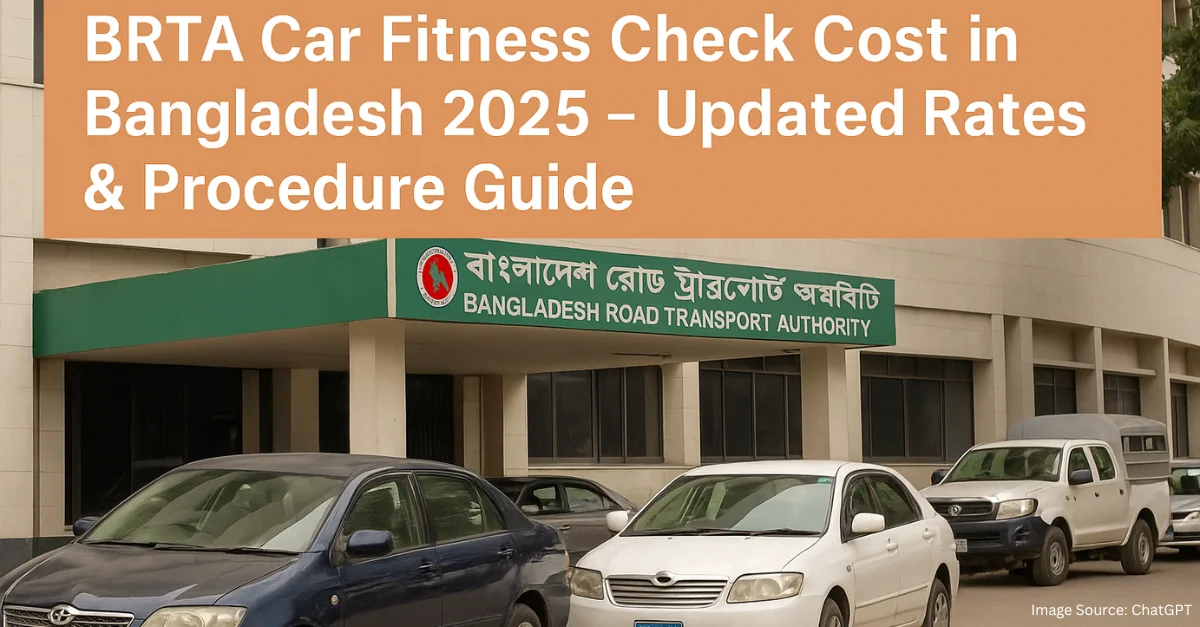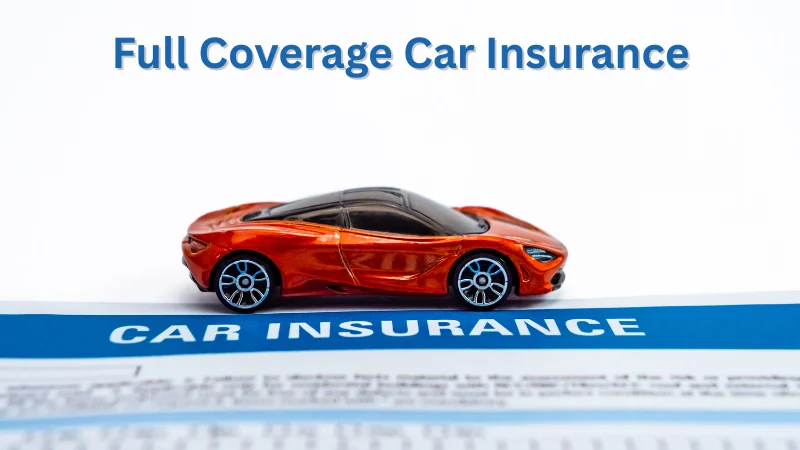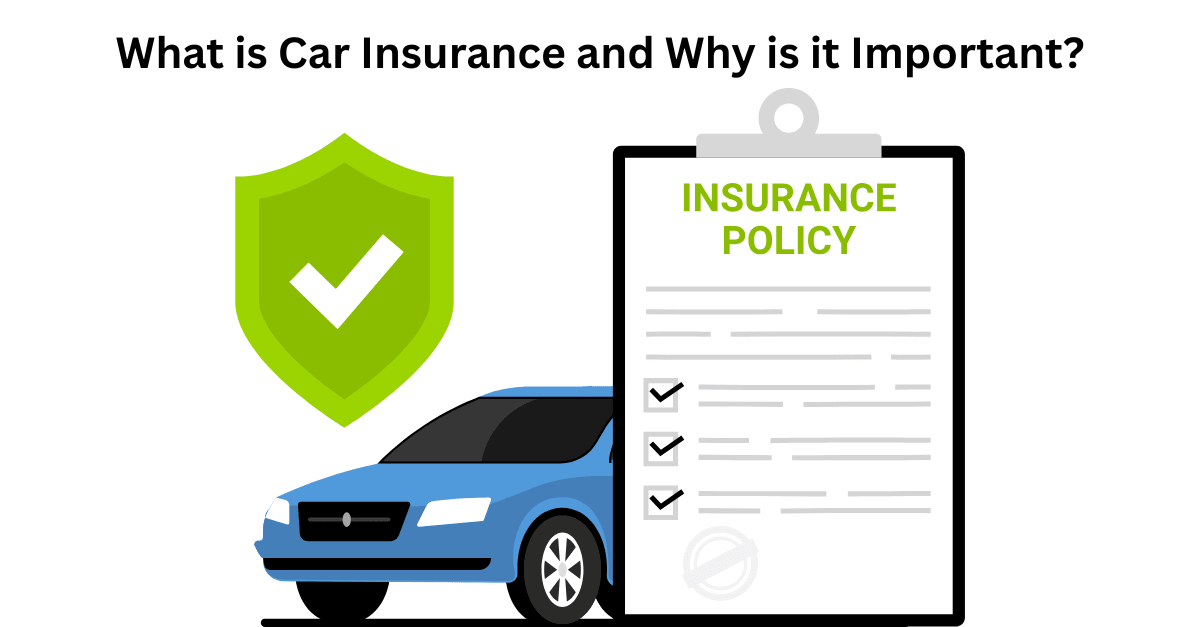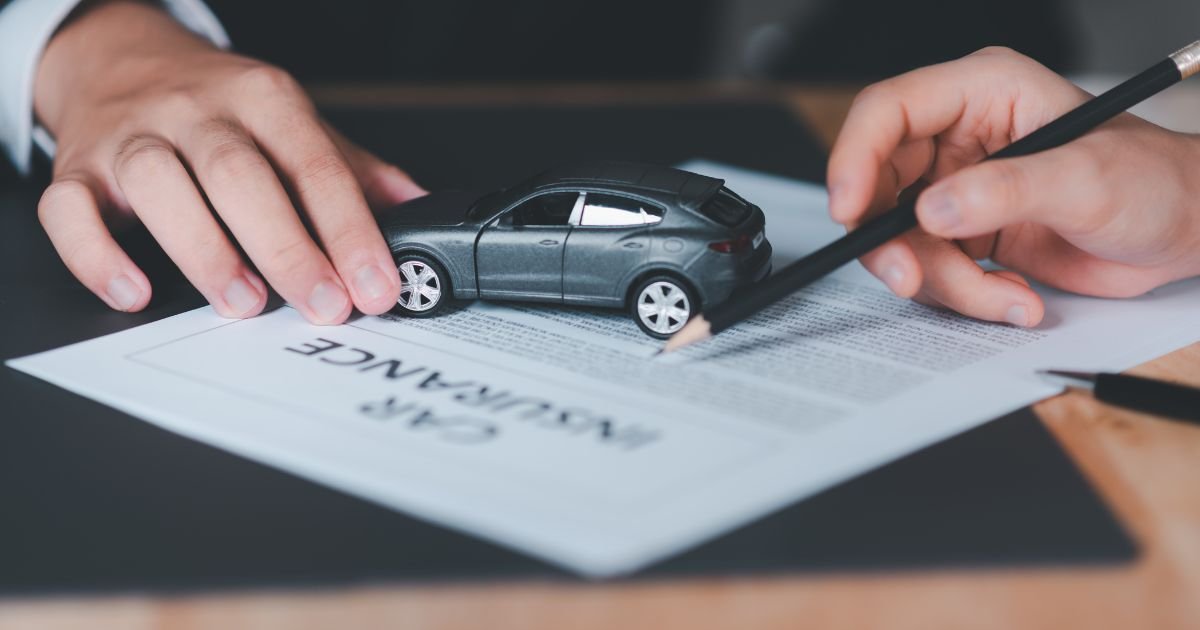Car Registration Cost in Bangladesh 2025
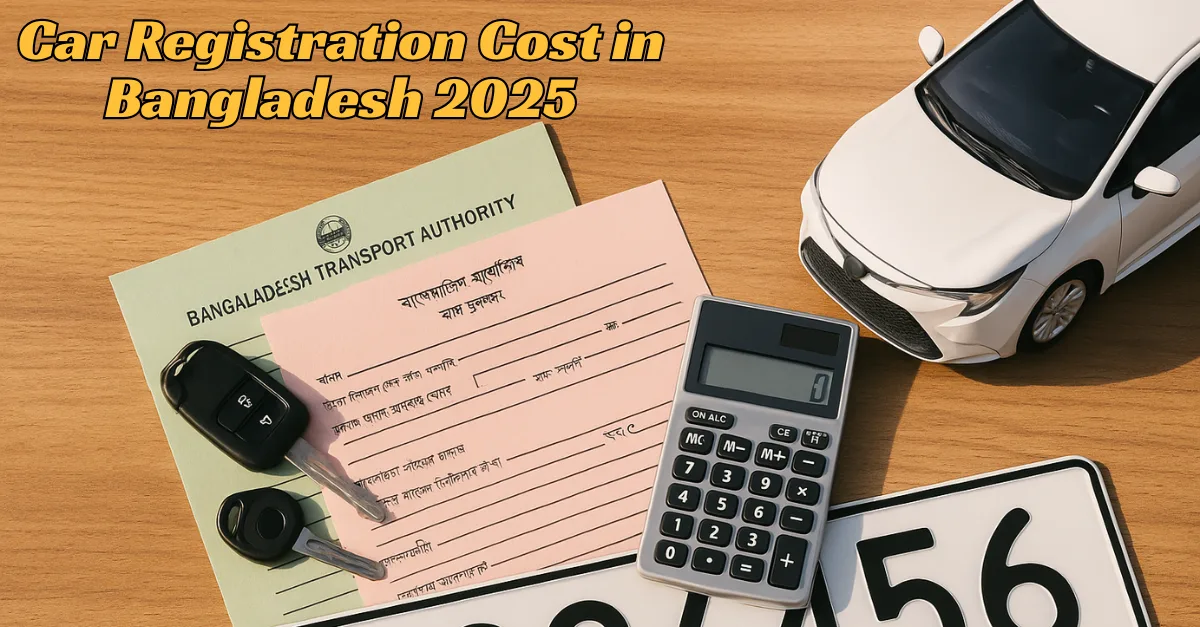
Car Registration Cost in Bangladesh 2025: Fees, Taxes, Process, Engine Capacity, New vs Used
Buying a car in Bangladesh is exciting, but once you get into the registration costs, things can get confusing fast. It’s not just one fee—there’s the BRTA charge, number plate, smart card, yearly tax token, and sometimes AIT or environmental surcharge. In 2025, the total cost depends on your car’s engine size and whether it’s brand-new or used. I’ve been through the process myself, so I’m sharing everything clearly and simply—just like I’d explain it to a friend. From documents to payments, this post will help you stay ready and avoid last-minute surprises.
What I mean by car registration cost in 2025
When I talk about car registration cost, I don’t picture one number. I see a tidy basket that makes the car legal on the road. My basket has a few familiar items: the base registration fee, the number plate with RFID, the smart card, and the first fitness or inspection if it applies to my case. Then I add the yearly tax token fee, because I want a full picture—not a surprise six months later. Some owners also face an at‑source tax collected during registration (people call it AIT). On top of that, there is an environmental surcharge that may apply if someone owns more than one car; it’s tied to engine capacity bands. Because rules change, I check official pages before I leave home. If my engine is bigger, I expect higher recurring costs, so I compare two nearby engine sizes and do a five‑year view. This guide is just me sharing what I do—clear steps, calm tone, and zero fluff. My goal is simple: you read once, you feel ready, and you don’t stand at a counter feeling lost. I write the way I speak, and I keep examples grounded in Dhaka life, not theory. I’m writing this the way I talk to a friend at a tea stall in Dhaka—short, clear, and honest—so you can finish BRTA work without stress or guesswork.

The quick process I follow at BRTA
I keep my vehicle registration process clean because I’m allergic to wasted time. I gather a neat file: NID, TIN, proof of address, purchase invoice, and customs release if the car is imported. I circle chassis and engine numbers with a pencil so any officer sees them fast. I fill the application (parts are online now), write my phone number on the top‑right of each page, and carry a small envelope with passport photos and photocopies. At the office I pay the base fee, plate fee, and smart card fee. If the AIT surcharge Bangladesh rules touch my case, I settle it at the same time so I don’t have to return. I save PDFs on my phone in case a counter wants a fresh print. With a clean file, Dhaka cases can wrap in a day; tricky mismatches may take two or three working days. Before I leave, I double‑check spelling on my smart card and the plate slip and request corrections on the spot. Tiny habits make the whole day calmer—and cheaper. I’m writing this the way I talk to a friend at a tea stall in Dhaka—short, clear, and honest—so you can finish BRTA work without stress or guesswork.

Main fee families I budget for
When friends ask me about car registration fees Bangladesh, I never throw a single figure. I show them the fee families I budget for and how I split money into one‑time versus yearly. One‑time items: base BRTA registration fee, number plate with RFID, smart card, and sometimes the first fitness or inspection. Yearly: the tax token fee, and fitness at the set interval. If the rules require an advance tax for my case, I add that at registration. Last, if I own more than one car, I watch the environmental surcharge, which depends on the engine band. I confirm numbers on official pages because policies do get updates. A five‑minute check prevents a long line turning into a long day. If you like spreadsheets, make two columns and list the items underneath. That single page makes it easy to compare two cars and pick what suits today’s wallet and tomorrow’s routine. I’m writing this the way I talk to a friend at a tea stall in Dhaka—short, clear, and honest—so you can finish BRTA work without stress or guesswork. I’m writing this the way I talk to a friend at a tea stall in Dhaka—short, clear, and honest—so you can finish BRTA work without stress or guesswork.
| Item | What it covers | When I pay |
|---|---|---|
| Base registration fee | Core BRTA processing | One time at first registration |
| Number plate + RFID | Official plates and tagging | One time at first registration |
| Smart card | Registration certificate card | One time at first registration |
| Tax token fee | Yearly road tax | Every year at renewal |
| Fitness/inspection | Road‑worthiness checks | At setup; then periodic |
| AIT (if applicable) | At‑source tax at registration | At registration |
| Environmental surcharge | For individuals with multiple cars | At registration or fitness renewal |
BRTA Circle Fees 2025 (Updated: August 2025)
Dhaka Circle
| Engine band | Base registration fee | Yearly tax token fee | Environmental surcharge (if applicable) |
|---|---|---|---|
| Up to 1500cc | ৳35,000 | ৳5,000 | ৳25,000 |
| 1501–2000cc | ৳50,000 | ৳7,500 | ৳50,000 |
| 2001–2500cc | ৳75,000 | ৳10,000 | ৳75,000 |
| 2501–3000cc | ৳120,000 | ৳15,000 | ৳150,000 |
| 3001–3500cc | ৳150,000 | ৳20,000 | ৳200,000 |
| 3500cc+ | ৳200,000 | ৳25,000 | ৳350,000 |
Chattogram Circle
| Engine band | Base registration fee | Yearly tax token fee | Environmental surcharge (if applicable) |
|---|---|---|---|
| Up to 1500cc | ৳33,000 | ৳4,800 | ৳25,000 |
| 1501–2000cc | ৳48,000 | ৳7,200 | ৳50,000 |
| 2001–2500cc | ৳72,000 | ৳9,800 | ৳75,000 |
| 2501–3000cc | ৳115,000 | ৳14,500 | ৳150,000 |
| 3001–3500cc | ৳145,000 | ৳19,500 | ৳200,000 |
| 3500cc+ | ৳195,000 | ৳24,500 | ৳350,000 |
Khulna Circle
| Engine band | Base registration fee | Yearly tax token fee | Environmental surcharge (if applicable) |
|---|---|---|---|
| Up to 1500cc | ৳34,000 | ৳4,900 | ৳25,000 |
| 1501–2000cc | ৳49,000 | ৳7,300 | ৳50,000 |
| 2001–2500cc | ৳74,000 | ৳9,900 | ৳75,000 |
| 2501–3000cc | ৳118,000 | ৳14,800 | ৳150,000 |
| 3001–3500cc | ৳148,000 | ৳19,800 | ৳200,000 |
| 3500cc+ | ৳198,000 | ৳24,800 | ৳350,000 |
Sylhet Circle
| Engine band | Base registration fee | Yearly tax token fee | Environmental surcharge (if applicable) |
|---|---|---|---|
| Up to 1500cc | ৳34,500 | ৳5,000 | ৳25,000 |
| 1501–2000cc | ৳49,500 | ৳7,400 | ৳50,000 |
| 2001–2500cc | ৳74,500 | ৳10,000 | ৳75,000 |
| 2501–3000cc | ৳118,500 | ৳14,900 | ৳150,000 |
| 3001–3500cc | ৳148,500 | ৳19,900 | ৳200,000 |
| 3500cc+ | ৳198,500 | ৳24,900 | ৳350,000 |
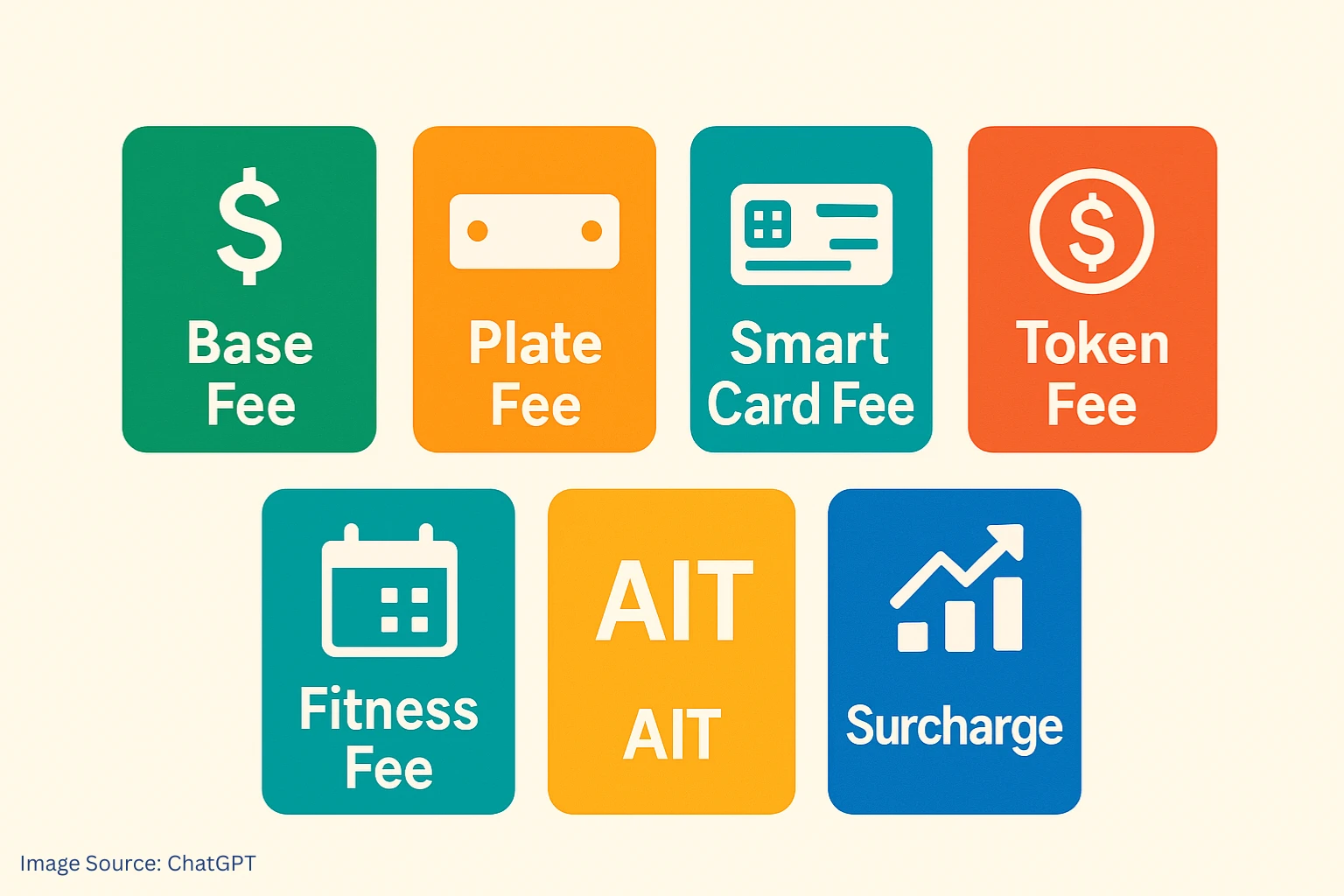
Engine capacity and why it changes the math
Engine size is the quiet lever that moves the bill. A 1500cc car and a 3000cc car can look similar on the road but live in different cost neighborhoods. The engine capacity registration fee effects and the yearly token vary by band, so I always compare trims next to each other and pencil in a five‑year total. If a model offers a turbo 1.5 and a non‑turbo 2.0, I don’t only test‑drive; I check what the bigger engine means for my tax token fee and any surcharge if I already own a car. City driving often favors the lighter engine. Highway comfort is lovely, but I don’t jump to a higher band unless I really need it. Writing the math down stops impulse buys and lets me explain the decision to my family in normal language. Smart choices feel good every month, not just on the day I get the keys. I’m writing this the way I talk to a friend at a tea stall in Dhaka—short, clear, and honest—so you can finish BRTA work without stress or guesswork. I’m writing this the way I talk to a friend at a tea stall in Dhaka—short, clear, and honest—so you can finish BRTA work without stress or guesswork.
About AIT and environmental surcharge
Two items create confusion, so I keep them simple. First, AIT (an at‑source tax) may be collected when I register. Whether it applies depends on the rules in force, my owner type, and the engine band. Second, the environmental surcharge can apply if someone owns more than one private motor car; it’s linked to engine capacity or motor power and is collected at registration or at fitness renewal. I don’t guess—I confirm with current circulars and plan a small cash cushion. If I discover it doesn’t apply, great; the cushion helps at renewal time anyway. When a showroom chat turns to AIT surcharge Bangladesh, I treat it like a policy fact, not a scary surprise. Calm, written math beats last‑minute panic every time. I’m writing this the way I talk to a friend at a tea stall in Dhaka—short, clear, and honest—so you can finish BRTA work without stress or guesswork. I’m writing this the way I talk to a friend at a tea stall in Dhaka—short, clear, and honest—so you can finish BRTA work without stress or guesswork. I’m writing this the way I talk to a friend at a tea stall in Dhaka—short, clear, and honest—so you can finish BRTA work without stress or guesswork.
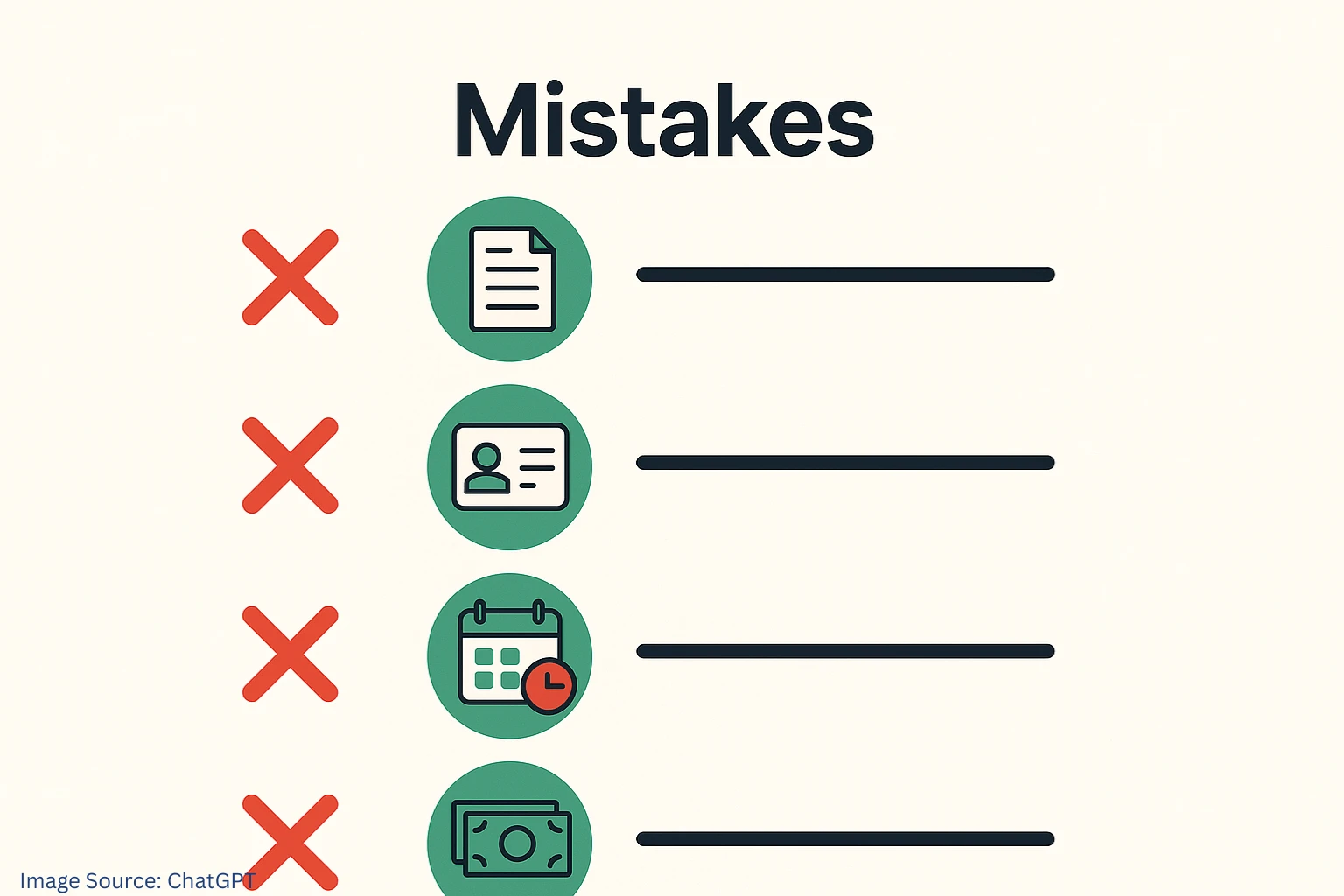
Yearly token and fitness rhythm
After the first registration, the yearly rhythm begins. I set reminders for the tax token fee and for fitness because those renewals keep me legal and save me from fines or delays during checks. I save receipts in a cloud folder with names like “Token_2025_Ahsan.pdf.” If I travel, I renew early to miss the end‑of‑month queue. Fitness isn’t just a stamp; it’s a moment to confirm the car is safe. If surcharge collection links to a renewal for people who own more than one car, I plan that cash too so I don’t make two trips. I look at the full year, not only the purchase month, and I keep my paperwork clean so traffic checks are two‑minute events, not two‑hour stories. I’m writing this the way I talk to a friend at a tea stall in Dhaka—short, clear, and honest—so you can finish BRTA work without stress or guesswork. I’m writing this the way I talk to a friend at a tea stall in Dhaka—short, clear, and honest—so you can finish BRTA work without stress or guesswork. I’m writing this the way I talk to a friend at a tea stall in Dhaka—short, clear, and honest—so you can finish BRTA work without stress or guesswork.
New vs used—how I decide calmly
People assume a new car registration cost is always higher and a used car registration cost is always lower, but the answer lives in the file. New cars are straightforward: I pay the one‑time items, collect plates and the smart card, and I’m done. Used cars can add a transfer fee, possible new plates if I change districts, and quick renewals if token or fitness dates are near. I never pay a deposit until I see a full, clean set of papers. I match the seller’s NID/TIN with the smart card, check for unpaid fines, and read the chassis and engine numbers slowly with a flashlight if needed. A lower purchase price can be swallowed by a higher engine band, so I balance the upfront deal with the future bills. The best choice is the one I can drive happily and pay for calmly all year. I’m writing this the way I talk to a friend at a tea stall in Dhaka—short, clear, and honest—so you can finish BRTA work without stress or guesswork. I’m writing this the way I talk to a friend at a tea stall in Dhaka—short, clear, and honest—so you can finish BRTA work without stress or guesswork.
Sample budgets I use when comparing
I don’t chase perfect figures; I use sample budgets so I can compare shapes. For a 1500cc city hatch, I expect the friendliest token band and a gentle setup. For a mid sedan in the 2000–2500cc range, I plan for a clear step up. For a big SUV over 3000cc, I treat the numbers as premium territory and make sure I’m truly okay with the ongoing spend. My one‑page table has four columns: item, what it covers, when I pay, and notes. I reuse the same sheet for every car I consider. When money is tight, choosing a lower engine band is more powerful than bargaining a small discount at purchase. If I already own a car, I confirm whether surcharge rules touch me before I sign. Calm planning has saved me from impulse buys more than once—and it keeps the family conversation easy and honest. I’m writing this the way I talk to a friend at a tea stall in Dhaka—short, clear, and honest—so you can finish BRTA work without stress or guesswork. I’m writing this the way I talk to a friend at a tea stall in Dhaka—short, clear, and honest—so you can finish BRTA work without stress or guesswork.
Documents and small habits that save time
The fastest way I move through BRTA is by acting like a polite, prepared person. I bring a tidy folder with labeled sections: ID, tax, purchase, customs, insurance, and application. I write my phone number on the top‑right of every page so a counter officer can call me if needed. I carry a black pen, a few clips, and several photocopies. I scan each document to my phone with clear names like “NID_Rafi_2025.pdf.” If a counter asks for a copy, I can provide it without leaving the line. I arrive early, dress light, and read the office notice board for fresh instructions. When mistakes happen—like a letter missing from my address—I request a correction on the spot. Over time, these habits save more hours than any “hack,” and they keep my stress low. I want to finish my work, grab a tea, and move on with my day. I’m writing this the way I talk to a friend at a tea stall in Dhaka—short, clear, and honest—so you can finish BRTA work without stress or guesswork. I’m writing this the way I talk to a friend at a tea stall in Dhaka—short, clear, and honest—so you can finish BRTA work without stress or guesswork.
Common mistakes I avoid now
I earned this list the hard way. First, I don’t let my NID name differ from the name on my application. Second, I read chassis and engine numbers slowly and match them against the invoice and form. Third, I don’t assume last year’s fees equal this year’s; I confirm. Fourth, I pin token and fitness dates to my calendar and set a reminder. Fifth, I never hand over money for a used car until I’ve seen a full set of matching papers. If the process feels heavy, I ask someone experienced at the same office, then cross‑check with official sources. My aim isn’t to “beat” the system; it’s to respect it and finish fast without drama. Little by little, the routine becomes easy, and I get to enjoy the drive instead of worrying about paperwork. I’m writing this the way I talk to a friend at a tea stall in Dhaka—short, clear, and honest—so you can finish BRTA work without stress or guesswork. I’m writing this the way I talk to a friend at a tea stall in Dhaka—short, clear, and honest—so you can finish BRTA work without stress or guesswork. I’m writing this the way I talk to a friend at a tea stall in Dhaka—short, clear, and honest—so you can finish BRTA work without stress or guesswork.
Engine capacity bands and current surcharge rates
Now to the specific engine capacity bands most people ask me about. I’m listing the environmental surcharge amounts that apply to a person who owns more than one private motor car. These are not the whole registration bill; they are the extra policy amounts tied to engine size for second and subsequent cars. The current public guidance shows these bands: up to 1500cc (or 75 kW) — ৳25,000; 1501–2000cc (or up to 100 kW) — ৳50,000; 2001–2500cc (or up to 125 kW) — ৳75,000; 2501–3000cc (or up to 150 kW) — ৳150,000; 3001–3500cc (or up to 175 kW) — ৳200,000; and 3500cc+ (or over 175 kW) — ৳350,000. Companies and firms have been exempted from this surcharge according to widely reported guidance, so the rule targets individuals with multiple cars. The surcharge is usually collected at BRTA registration or when renewing fitness, and it sits on top of your usual token and other fees. I treat these figures as policy anchors. For day‑to‑day math, I still run my plate and engine through the official tools to catch any fresh notice. A calm five‑minute check protects me from last‑minute scrambles and lets me pick a trim level that matches both my heart and my wallet.
| Engine band | Environmental surcharge (2nd+ private car) | Notes |
|---|---|---|
| Up to 1500cc (≤75 kW) | ৳25,000 | Collected at registration or fitness renewal |
| 1501–2000cc (≤100 kW) | ৳50,000 | Applies to individuals with more than one car |
| 2001–2500cc (≤125 kW) | ৳75,000 | Applies per additional car |
| 2501–3000cc (≤150 kW) | ৳150,000 | Policy rates per public guidance |
| 3001–3500cc (≤175 kW) | ৳200,000 | See latest NBR circular for any change |
| 3500cc+ (>175 kW) | ৳350,000 | Highest current band reported |
Frequently Asked Questions (FAQs)
How much is the total car registration cost for a small car?
For a small city car I budget in two layers: one‑time items (base BRTA fee, plates with RFID, smart card, initial fitness) and yearly items (tax token, later fitness). If I already own a car, I check the environmental surcharge band as well. I confirm numbers on the official tools before I visit a counter so nothing surprises me.
Do I pay AIT at registration for every car?
No. AIT or at‑source tax can apply at registration depending on the rules in force, your owner type, and engine capacity band. Rather than guessing, I check the latest circulars and ask the BRTA counter to confirm before they print the challan. If it applies, I pay it with the other one‑time items and keep the receipt with my file.
What is the environmental surcharge and when is it collected?
It’s a policy charge for individuals who own more than one private motor car. The amount depends on engine size bands and is generally collected by BRTA at registration or during fitness renewal. I treat it as an extra line on top of token and other fees, and I verify my band right before payment so I can plan cash calmly.
Is the used car registration cost always cheaper than new?
Not automatically. Used cars can be cheaper upfront but may need transfer fees, new plates for a district change, or quick renewals if token or fitness dates are close. I never pay a deposit until I see a complete, clean set of papers that match the car. Then I compare the engine band’s yearly costs before deciding.
Can I do everything online?
Some parts are online—forms and checking fee logic—but I still usually visit a BRTA office for plates and the smart card. I keep both digital and paper copies ready. Booking a morning slot and carrying a neat folder helps me finish work in one visit. I also save all receipts in a cloud folder for traffic checks later.

